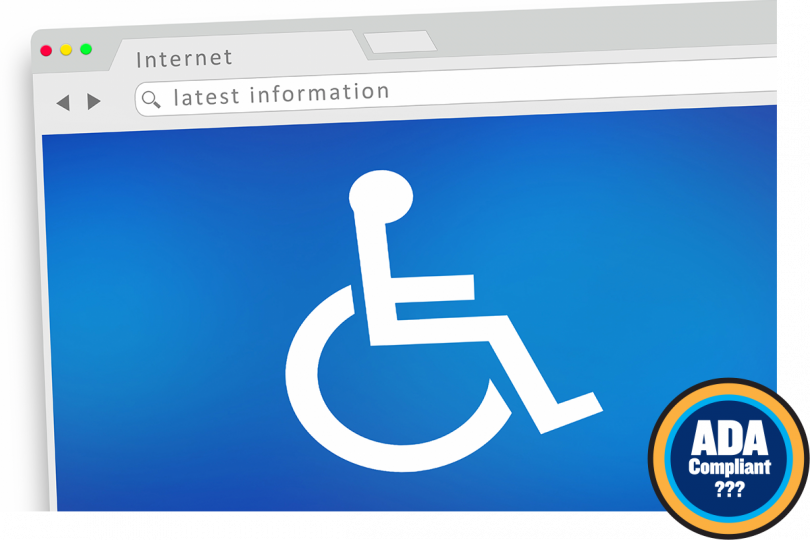Is your website ADA compliant? Can you be sure?
This cry for help is one we are hearing much too often these days, and more often than not, from a victim of a plaintiff’s lawyer looking for an easy payday. From restaurants, retail stores, art galleries, and banks, it seems no company is off limits from legal action over failure to meet ADA compliance standards. According to the Wall Street Journal, “The number of website-access lawsuits filed in federal court reached 2,250 in 2018, almost three times the 814 filed in 2017.” https://www.wsj.com/articles/lawsuits-surge-over-websites-access-for-the-blind-11550415600
So what is this all about?
Complaints usually detail the problems visually impaired individuals have when using the “screen reader” tools that will help them read the website aloud. The American Disabilities Act prohibits discrimination against the disabled in all places of public accommodation, but doesn’t explicitly say websites. In fact, the ADA was passed in 1990, before the “commercial” internet even began. Despite this, courts around the nation have interpreted the ADA to include websites connected to a physical business.
The cost of these claims can be significant. Companies face legal fees in responding to the demand or lawsuit, the cost of updating their website to be ADA compliant, occasionally liabilities for the claimant’s attorney fees, and finally the cost of settling the case. One national retailer settled a suit for $6 million, but on average, cases are coming in around $20,000 or less in attorney fees and costs, plus an agreement to improve websites within two years.
Companies often purchase an employment practices liability policy to protect them from discrimination, sexual harassment, or wrongful termination suits, but this will not protect them from cases of discrimination from non-employees.
What’s the best way to avoid being the next company hit with a lawsuit?
Conduct a compliance and prevention audit of your organization and create a plan for website accessibility. Speak to your employment counsel to understand how these rules apply to your business. Consider purchasing an employment practices liability policy with third party coverage. While the cost of making your website ADA compliant would not be covered, your defense expenses, plaintiff fees, and settlements generally are covered.
What are some ways I can begin to make my website ADA compliant?
Now that you’re prepared should someone come after you with a lawsuit, here are some steps you can take to begin to bring your site up to ADA compliance.
- Install a plugin or that works to help make your site ADA friendly. For example, WordPress plugins such as Userway, WP Accessibility, WP Accessibility Helper can work as readers, assist with navigation, change the visuals to be high contrast, and/or make text larger and easier to read. Do NOT consider a plug-in to be a “fix all” solution. It’s only a beginning.
- Make EVERYTHING readable! Include alt-text your images (these tell the readers what the image is). Alt-text prompts should describe the image in a simple but complete way, such as “woman laughing while holding a yellow coffee cup.” Additionally, if you upload any PDFs to your website, make sure they have an accompanying HTML (a.k.a. text-only) page where the it can be read by a digital reader. While much of the emphasis seems to be on those who have vision impairments, consideration also needs to be paid to consumers with hearing impairments. If you have audio files on your site, be sure to include transcripts. If you have videos on your site, be sure to include subtitles on all videos.
- Add an Accessibility Statement page.We highly suggest adding an Accessibility Statement page to your site, ideally with a link to it in the footer menu or via the contact page. This page is a place where your company can announce its commitment to accessibility. Be sure to include any measures you have or are taking to support accessibility, clearly state where your site ranks according to the Web Contact Accessibility Guidelines (WCAG), and have a designated spot for feedback and contact information.
- Stay current on the WCAG guidelines. The Web Contact Accessibility Guidelines (WCAG) (https://www.w3.org/TR/WCAG21/) is a list of recommendations put out by the Web Accessibility Initiative’s Accessibility Guidelines Working Group at w3.org. These guidelines detail out a comprehensive list of ways to make your site more accessible to people with disabilities. Be sure to follow the most recent version when implementing WCAG guidelines. This list is long and filled with technical detail. If you aren’t a web programmer, we highly suggest having an experienced web programming team handle site edits beyond the basics listed here.
While these four steps above are a great move in the right direction for compliance and company protection, they are not guarantees in protecting you from a lawsuit. Unfortunately, these lawsuits are becoming much more common which is why we suggest doing what you can to strengthen your company website’s ADA compliance, and getting the appropriate insurance coverage should any legal action come about.






